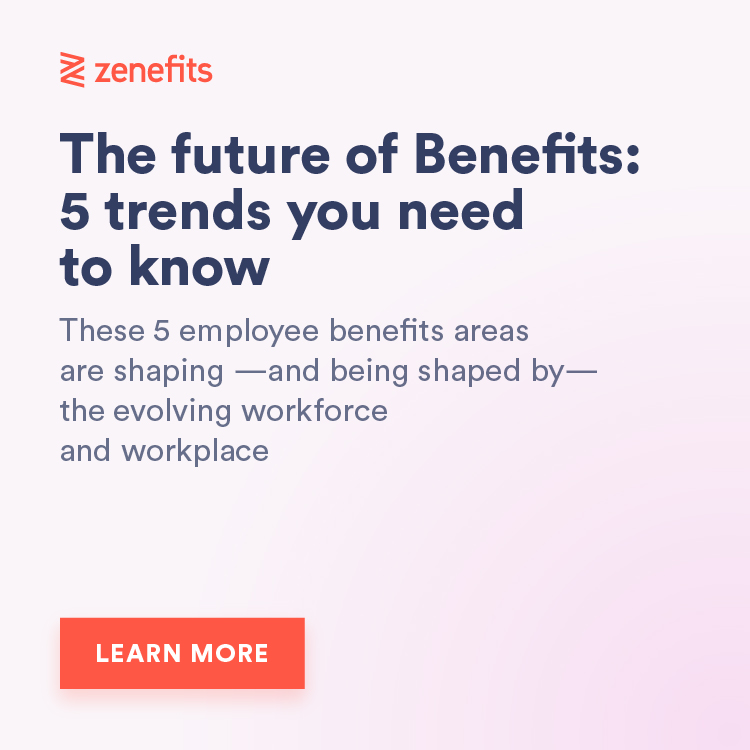Companies must implement innovative strategies to give their current benefits packages a major overhaul to stay competitive in 2023.

Here's what you need to know:
-
The competitive job market today calls for only the most cutting-edge benefits for recruiting and retaining the best talent
-
In fact, 88% of job seekers give some if not heavy consideration to jobs that offer the best health, dental, and vision insurance benefits
-
Employers should be aware of the benefits and compensation they are legally required to provide to employees
-
Employee benefits trends for 2023 include mental health and wellness benefits, remote or flexible work opportunities, and benefits for reproductive health and childcare
As 2022 comes to a close, companies may be reassessing their employee benefits packages for the new year. This may be especially due to the rising healthcare costs predicted to enter the market in the approaching year.
It may be time for businesses big and small to look over the benefits they offer. Then, they can determine how relevant and affordable they are. The competitive job market today calls for only the most cutting-edge benefits for recruiting and retaining the best talent.
In fact, 88% of job seekers give some if not heavy consideration to jobs that offer the best health, dental, and vision insurance benefits.
These individuals would often likely choose a job with better benefits over a high-paying job. These potential employees seek jobs with their best health and wellness interests in mind. However, companies need to understand one size doesn’t fit all.
The basic combination of employee benefits includes retirement plans, life insurance, healthcare plans, vision and/or dental insurance, and PTO. There are other supplemental benefits that an employer can make available to their employees as well.
Companies with a massive list of benefits in 2022 may come to realize that many of them don’t compare to the demands of the labor market. Competitors are using this opportunity to rake in as much talent as they can with enticing 401(k) plans and contract-signing bonuses.
For a company to differentiate itself from another, innovative strategies must be taken to give its current benefits packages a major overhaul.
What are federally mandated employee benefits?
Employers should be aware of the benefits and compensation they are legally required to provide to employees. Each state will have varying qualifications for these laws, so each of these should be confirmed by a company before throwing them out of a benefits package.
These include:
- Consolidated Omni-Budget Reconciliation Act — Companies with 20 employees or more are required by federal law to provide medical benefits to former employees for up to 18 months or more. Some states may have extra requirements for COBRA, so it’s worth it for employers to check out what will happen to a person if they lose their job, and what they can do to mitigate that.
- Family and Medical Leave Act — FMLA requires employers to provide at least 12 weeks of paid or unpaid maternity leave, paternity, or adoption leave. Each state has labor laws that can qualify a person for family medical leave. However, some employers are more forthcoming with paid leave as it pertains to a familial addition.
- Worker’s Compensation & Disability — This requires sick or injured employees to continue getting paid until they can go back to work. Some businesses may be exempt. Each state has its own set of requirements for meeting the criteria. Still, most employees across the U.S. are eligible for workers’ compensation if they are injured while on the clock.
- Fair Labor Standard Act — The FLSA sets the current federal minimum wage, which must be abided by. The FLSA also requires overtime laws to be enacted by each state, stipulating overtime pay requirements.
What are employee benefits trends for companies in 2023?
Casual Fridays and free coffee just don’t have the same ring to them anymore. The same goes for medical service packages and company-issued technology.
These “benefits” are run-of-the-mill and generally expected of most employers. Human resources should be paying attention to and keeping up with competitive employee benefits package trends that attract the most potential workers.
Mental health and wellness
Executives from a recent survey believe that employees expect too much mental health support. Furthermore, they’ve said that offering mental health benefits is too costly. They don’t believe it should be a priority. In some cases, that’s because they weren’t given those same benefits earlier in their careers.
Contrary to what these executives believe, 81% of employees will consider jobs that put mental health as a priority when seeking a job. The stark contrast in CEO beliefs and the beliefs of the mental healthcare-starved population is enough to understand that enough simply isn’t being done to combat mental health crises.
Employee Assistance Programs (EAP) are great places to start as an offering for mental health. These programs assist with non-medical issues that may be impactful in a person’s work and home life.
These issues, such as depression, anxiety, sleep disturbances, and more, are met with confidential counseling and resources to alleviate mental health conditions.
The disconnect between employers and employees can be bridged with more than just access to mental healthcare, however. An employer’s mental wellness program can also include other beneficial features, like:
- Company gym memberships
- Free subscriptions to mental health apps and events
- Yoga classes
- Designated offices specifically for mental health purposes
- Quarterly mental health PTO
For CEOs who believe catering to employees’ mental health is too expensive, perhaps a simple wellness newsletter or daily check-in will suffice. If employers couple this with creative ideas for thoroughly enhancing the mental health of essential employees, including it in a benefits package will look attractive to job seekers.
Remote/flexible work
Employees appreciate the opportunity to work from home now more than ever. With reports of better productivity and higher preference, 61% of employees choose to work from home, even when given the option to go back to the office.
Employees appreciate the opportunity to work from home now more than ever.
As more and more companies are going partially or fully remote, 2023 will see a high demand for remote opportunities. As such, remote or hybrid work will be a perfect addition to a benefits package.
Remote or hybrid work may not be feasible for all employers. However, they can still offer flexible work schedules that cater to the work/life balances of their employees. Employees will be grateful for the chance to adjust their hours as needed to make room for their individual needs.
Reproductive health
Women’s reproductive health has been a key concern for thousands of Americans as of late. The controversial Roe v. Wade decision of 2022 makes reproductive support a must-have in 2023.
HR leaders everywhere are using this opportunity to sweeten onboarding for women by improving parenting and pediatric support, bolstering maternity and menopause support, and expanding fertility coverage through medical reimbursements.
Some employers are ready to offer resources to support high-risk pregnancies, lactation, family planning, and pregnancy loss as well.
This can go even beyond reproductive matters and include the children of employees. Working parents struggle to balance their children’s caregiving needs and expenses with their demanding jobs.
Employer-funded childcare, on-site daycare, babysitting, and tutoring stipends are sure to win over working parents. This especially goes for those women directly impacted by the Supreme Court’s decision.
What’s your biggest 2022 HR challenge that you’d like to resolve
Answer to see the results
Determine the benefits that are most important to your staff
Another facet employers may want to consider is the common demographic of their company. For example, if a business holds 70% men to 30% women, employees may not bat an eye at reproductive benefits. Instead, it would help to make benefits like these voluntary.
The “Great Resignation” has shown the true power of the people, as many quit their jobs in droves, even as the COVID-19 pandemic calmed down.
Employers must remember that constructing their 2023 benefits packages will require a bit of research. They should consider conducting employee benefits satisfaction surveys to determine what’s most important to their employees.
That way, they can align what they offer with the most relevant benefits. With inflation causing costs to skyrocket, employees are looking to their employers for assistance with their lives now more than ever.







